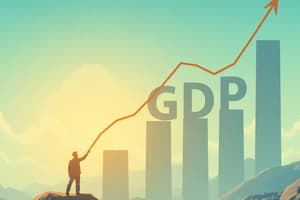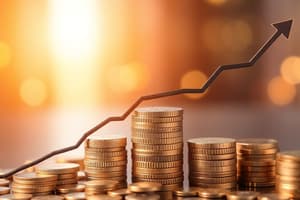Podcast
Questions and Answers
What is a key application of time series econometrics?
What is a key application of time series econometrics?
- Designing optimal tax policies
- Developing pricing strategies for firms
- Conducting market surveys
- Forecasting GDP growth (correct)
Which concept describes the prolonged period of low growth and interest rates associated with demographic shifts and technological saturation?
Which concept describes the prolonged period of low growth and interest rates associated with demographic shifts and technological saturation?
- Secular stagnation (correct)
- Hyperinflation
- Stagflation
- Recession
Which area of study focuses on the strategic interactions between economic agents like governments and central banks?
Which area of study focuses on the strategic interactions between economic agents like governments and central banks?
- Game theory (correct)
- Computational economics
- Time series econometrics
- Behavioral economics
What challenges arise from the disconnect between rapid technological advancements and sluggish productivity growth?
What challenges arise from the disconnect between rapid technological advancements and sluggish productivity growth?
What does behavioral macroeconomics integrate to explain anomalies like loss aversion and herd behavior?
What does behavioral macroeconomics integrate to explain anomalies like loss aversion and herd behavior?
What is a primary concern when analyzing debt sustainability in the context of rising inequality?
What is a primary concern when analyzing debt sustainability in the context of rising inequality?
What is a primary focus of rules-based monetary policy under commitment?
What is a primary focus of rules-based monetary policy under commitment?
Which factor is NOT considered when analyzing fiscal multipliers in open economies?
Which factor is NOT considered when analyzing fiscal multipliers in open economies?
Unconventional monetary policies are particularly useful in which situation?
Unconventional monetary policies are particularly useful in which situation?
Which model is used to explain exchange rate dynamics in open economies?
Which model is used to explain exchange rate dynamics in open economies?
What impact does reserve accumulation by surplus economies have?
What impact does reserve accumulation by surplus economies have?
What is a primary goal of macroprudential regulations?
What is a primary goal of macroprudential regulations?
Which factor is NOT typically studied in the context of climate change and macroeconomic implications?
Which factor is NOT typically studied in the context of climate change and macroeconomic implications?
What do forward guidance strategies primarily aim to influence?
What do forward guidance strategies primarily aim to influence?
Which of the following concepts relates to macroeconomic stabilization under uncertainty?
Which of the following concepts relates to macroeconomic stabilization under uncertainty?
What is one implication of the macroeconomic trilemma for policymakers?
What is one implication of the macroeconomic trilemma for policymakers?
What is the primary focus of macroeconomics?
What is the primary focus of macroeconomics?
Which of the following best describes Dynamic Stochastic General Equilibrium (DSGE) models?
Which of the following best describes Dynamic Stochastic General Equilibrium (DSGE) models?
What is a key feature of endogenous growth theory?
What is a key feature of endogenous growth theory?
How does chaos theory relate to macroeconomic dynamics?
How does chaos theory relate to macroeconomic dynamics?
What do Heterogeneous Agent Models (HAMs) differ from in their approach?
What do Heterogeneous Agent Models (HAMs) differ from in their approach?
What is the central concept of intertemporal budget constraints?
What is the central concept of intertemporal budget constraints?
Which component is crucial for understanding the propagation of economic shocks in DSGE models?
Which component is crucial for understanding the propagation of economic shocks in DSGE models?
What is a primary criticism of traditional equilibrium-based approaches in macroeconomics?
What is a primary criticism of traditional equilibrium-based approaches in macroeconomics?
In the context of growing economies, what role do research and development play according to endogenous growth theory?
In the context of growing economies, what role do research and development play according to endogenous growth theory?
Flashcards
Secular Stagnation
Secular Stagnation
A period of prolonged low growth and interest rates, often attributed to factors like demographic shifts, technological saturation, and income inequality.
Computational Economics
Computational Economics
The use of mathematical models and simulations to study economic systems using computers. It analyzes how people make economic choices.
Game Theory in Policy Design
Game Theory in Policy Design
A branch of economics that studies how people make decisions in situations where their actions affect others. It analyzes strategic interactions between economic agents.
Microfoundations of Macroeconomics
Microfoundations of Macroeconomics
Signup and view all the flashcards
Post-Keynesian Economics
Post-Keynesian Economics
Signup and view all the flashcards
Behavioral Macroeconomics
Behavioral Macroeconomics
Signup and view all the flashcards
DSGE Models
DSGE Models
Signup and view all the flashcards
Endogenous Growth Theory
Endogenous Growth Theory
Signup and view all the flashcards
Chaos Theory in Macroeconomics
Chaos Theory in Macroeconomics
Signup and view all the flashcards
Heterogeneous Agent Models (HAMs)
Heterogeneous Agent Models (HAMs)
Signup and view all the flashcards
Intertemporal Budget Constraints
Intertemporal Budget Constraints
Signup and view all the flashcards
Growth Theory
Growth Theory
Signup and view all the flashcards
Representative Agent Model
Representative Agent Model
Signup and view all the flashcards
Exogenous Growth Model
Exogenous Growth Model
Signup and view all the flashcards
Dynamic Stochastic General Equilibrium (DSGE) Modeling
Dynamic Stochastic General Equilibrium (DSGE) Modeling
Signup and view all the flashcards
Rules-Based Monetary Policy
Rules-Based Monetary Policy
Signup and view all the flashcards
Credibility of Central Banks
Credibility of Central Banks
Signup and view all the flashcards
Fiscal Multipliers in Open Economies
Fiscal Multipliers in Open Economies
Signup and view all the flashcards
Unconventional Monetary Policies
Unconventional Monetary Policies
Signup and view all the flashcards
Macroeconomic Stabilization under Uncertainty
Macroeconomic Stabilization under Uncertainty
Signup and view all the flashcards
Mundell-Fleming Model
Mundell-Fleming Model
Signup and view all the flashcards
Dornbusch Overshooting Model
Dornbusch Overshooting Model
Signup and view all the flashcards
Global Imbalances
Global Imbalances
Signup and view all the flashcards
Financial Crises and Systemic Risks
Financial Crises and Systemic Risks
Signup and view all the flashcards
Climate Change and Sustainability
Climate Change and Sustainability
Signup and view all the flashcards
Study Notes
Macroeconomics: A Comprehensive Analysis
- Macroeconomics studies national and global economies, focusing on aggregate variables and long-term growth.
- It examines complex interdependencies among economic factors.
- It aims to understand short-term fluctuations and inform policy interventions.
Advanced Concepts in Macroeconomics
Dynamic Stochastic General Equilibrium (DSGE) Models
- Sophisticated mathematical frameworks analyzing economic evolution over time.
- Considers random shocks (e.g., technological advancements, policy changes).
- Incorporates forward-looking behavior, intertemporal choices, and constraints faced by economic actors (households, firms, policymakers).
- Used for forecasting, policy simulation, and understanding economic shock propagation.
Endogenous Growth Theory
- Contrasts traditional exogenous models (e.g., Solow-Swan).
- Argues that economic growth originates within the system, driven by innovation, knowledge spillovers, and human capital investment.
- Highlights the importance of R&D, institutional frameworks, and scale effects in driving productivity.
Nonlinear Dynamics and Chaos Theory
- Real-world economies often exhibit complex, unpredictable patterns (e.g., business cycles, bubbles).
- Chaos theory explores how small initial changes can lead to significant consequences, challenging traditional equilibrium-based approaches.
Heterogeneous Agent Models (HAMs)
- Models acknowledge diversity among economic agents (different preferences, resources, decision-making).
- Provides deeper insights into inequality, financial markets, and consumption-saving behavior.
Intertemporal Budget Constraints
- Focuses on agents' lifetime decision-making, balancing present and future consumption with factors like income, interest rates, and uncertainty.
Advanced Topics in Policy Frameworks
Optimal Monetary Policy under Commitment
- Examines rules-based vs. discretionary policies, emphasizing central bank credibility and reputation.
- Considers managing inflation expectations through forward guidance and Taylor rules.
Fiscal Multipliers in Open Economies
- Analyzes fiscal policy effectiveness in economies with international trade and capital mobility.
- Incorporates leakage effects, exchange rate dynamics, and sovereign debt constraints.
Unconventional Monetary Policies
- Includes tools like quantitative easing (QE), negative interest rates, and forward guidance to address liquidity traps and persistent inflation.
Macroeconomic Stabilization under Uncertainty
- Policymakers' strategies to mitigate the impact of unpredictable economic shocks using techniques like robust optimization.
Global Dimensions of Macroeconomics
International Capital Flows and Exchange Rates
- Covers advanced theories like the Mundell-Fleming model and Dornbusch model.
- Explains implications of global capital mobility, currency crises, and macroeconomic trilemmas.
Global Imbalances and Reserve Accumulation
- Investigates the roles of surplus and deficit economies in global imbalances.
- Discusses how reserve accumulation affects exchange rates and international trade.
Financial Crises and Systemic Risks
- Explores models of contagion, leverage cycles, and network effects in interconnected financial systems.
- Analyses the role of macroprudential regulations in mitigating systemic risks.
Macroeconomic Tools and Challenges
Climate Change and Sustainability
- Studies macroeconomic implications of environmental policies, carbon taxes, and green growth strategies.
- Incorporates the dynamic interplay between economic development and ecological constraints.
Time Series Econometrics
- Macroeconomic data analysis using tools like vector autoregressions (VARs), cointegration, and Granger causality.
Computational Economics
- Numerical simulations and agent-based modeling to solve complex dynamic systems.
Game Theory in Policy Design
- Explores strategic interactions between economic agents (e.g., governments, central banks).
Secular Stagnation
- Prolonged period of low growth and interest rates due to demographic shifts, technological saturation, and income inequality.
Digital Economy and Productivity Paradox
- Investigation into the apparent disconnect between rapid technological advancements and sluggish productivity growth.
Debt Sustainability in an Era of Rising Inequality
- Examination of debt sustainability amidst increasing inequality.
Decentralized Finance (DeFi) and Cryptocurrencies
- Analysis of implications focusing on monetary sovereignty, financial stability, and cross-border financial flows.
Philosophical and Theoretical Debates
- Microfoundations of Macroeconomics: Bridging macroeconomic models with individual decision-making.
- Post-Keynesian and Heterodox Economics: Critique of neoclassical dominance, emphasizing real-world complexities.
- Behavioral Macroeconomics: Integrates psychological insights to understand anomalies like irrational exuberance and loss aversion.
Studying That Suits You
Use AI to generate personalized quizzes and flashcards to suit your learning preferences.




